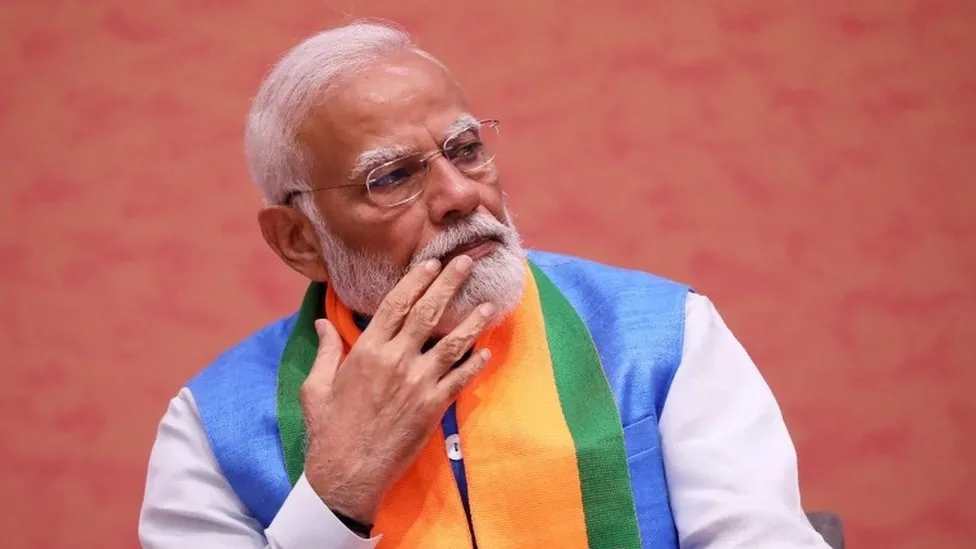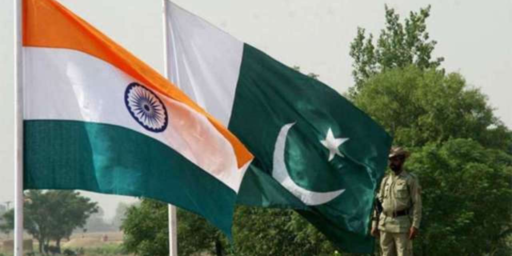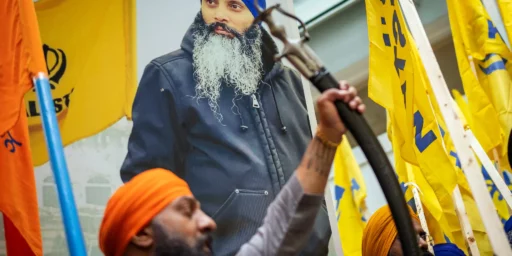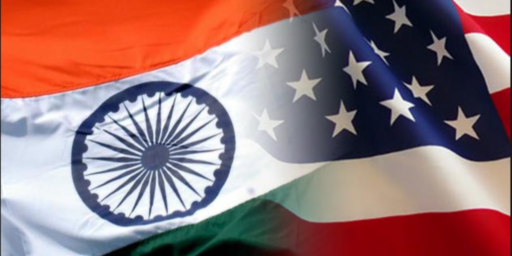Indian Voters Rebuke Modi
The world's largest democracy just became more democratic.

Sunday, I pointed to the three elections taking place in Mexico, India, and South Africa. The first and last of those went exactly as expected. Indian voters, though, defied expectations, sending a stern rebuke to the authoritarian Hindu nationalist regime that has governed for a decade.
An Economist leader says this is “A triumph for Indian democracy.”
The world’s biggest electorate has just shown how democracy can rebuke out-of-touch political elites, limit the concentration of power and change a country’s destiny. After a decade in charge, Narendra Modi was forecast to win a landslide victory in this year’s election; yet on June 4th it became clear that his party had lost its parliamentary majority, forcing him to rule through a coalition. The result partially derails the Modi project to renew India. It will also make politics messier, which has spooked financial markets. And yet it promises to change India for the better. This outcome lowers the risk of the country sliding towards autocracy, buttresses it as a pillar of democracy and, if Mr Modi is willing to adapt, opens a new path to reforms that can sustain its rapid development.
The drama unfolding amid a scorching heatwave begins with the election results. Mr Modi’s Bharatiya Janata Party (bjp) aimed to take up to 370 seats in the 543-member lower house, an even bigger majority than in 2014 or 2019. Instead it won just 240. It lost seats to regional parties in its heartlands in Uttar Pradesh and beyond, reflecting a revival of caste-based politics and, it seems, worries about a lack of jobs. Whereas his coalition partners were previously optional extras, he will now rely on them to stay in power. Their loyalty is not guaranteed.
This is not just an electoral upset, but a repudiation of Mr Modi’s doctrine of how to wield power in India. As our new podcast “The Modi Raj” explains, he is a remarkable man, born in poverty, schooled in Hindu-first ideology and consumed by the conviction that he was destined to restore India’s greatness. For Mr Modi, India has been kept down by centuries of rule under Islamic dynasties and British imperialists, followed after independence by socialism and the chaos inherent in diversity and federalism.
For over a decade Mr Modi’s answer has been to concentrate power. That meant winning elections decisively on a platform that emphasises his own brand, Hindu chauvinism and an aspirational message of rising prosperity. In office, his method has been to use executive might to ram through policies that boost growth and reinforce the bjp’s grip on power.
Mr Modi has changed India for good and ill. Fast growth promises to make its economy the world’s third-largest by 2027. India has better infrastructure, a new digital welfare system for the poor and growing geopolitical clout. However, good jobs are too scarce, Muslims suffer discrimination and, under a sinister illiberalism, the bjp has captured institutions and persecuted the media and opposition.
This year’s election was supposed to mark the next phase of the Modi Raj. With an even larger majority and a new presence in the richer south of the country, the bjp aspired to unitary authority across India at the central and state level. That might have made big-bang reforms easier in, say, agriculture. But such power also raised the threat of autocracy. Many in the bjp hoped to forge a single national identity, based on Hinduism and the Hindi language, and to change India’s liberal constitution, which they view as an effete Western construct.
Mr Modi would have reigned supreme. Yet every Raj comes to an end. If, as expected, the bjp and its allies form the next government, Mr Modi will have to chair a cabinet that contains other parties and which faces parliamentary scrutiny. That will come as a shock to a man who has always acted as a chief executive with unchallenged authority to take the big decisions. Succession will be debated, especially inside the bjp. Even if Mr Modi completes a full term, a fourth one is now less likely.
Mr Modi’s diminished stature brings dangers. He could resort to Muslim-bashing, as in the past. That would alienate many Indians but might possibly repair his authority with his base and the bjp. Coalition government makes forcing through economic changes harder. The small parties may gum up decision-making as they demand a share of the spoils. India’s growth is unlikely to fall below its underlying rate of 6-7%, but higher welfare spending may lead to cuts in vital investment. That explains why the stockmarket initially fell by 6%.
These dangers are real, but they are outweighed by the election’s promises. Now that the opposition has been revived, India is less likely to become an autocracy. The bjp and its allies also lack the two-thirds majority they needed to make many constitutional changes. Disappointed investors should remember that most of the value of their assets lies beyond the next five years and that the danger posed by democratic backsliding was not just to Indians’ liberty. If strongman rule degenerated into the arbitrary exercise of power, it would eventually destroy the property rights that they depend on.
India has, by most accounts, slightly surpassed China as the most populous country on the planet, with over 1.4 billion people. That they’re almost certainly going to be freer as a result of this election outcome is an unalloyed good.
The pre-election polling—and even the exit polling—had led to the expectation that BJP would significantly increase its parliamentary majority. Which, naturally, was seen as an indication that Modi’s anti-Islamic policies were quite popular. These results call that into question. And working as part of a coalition will almost certainly trim his sails.






The Guardian author only mentioned this in passing, but I think it’s an important insight. A driving force in all (small-c) conservative thought and political movements is a strong aversion to complexity, nonhomogeneity, and plurality — all of which are seen as “chaos”. For some conservatives it is merely an aesthetic aversion; for others it is an outright phobia. This is the plank of the conservative platform that supports reactionary movements to restore a mythical simpler past time. The time “when we were in charge and others knew their place” is attractive on both counts, with the latter just as important as the former.
This is the easiest way to see that US conservative defense of State’s Rights was always a smoke screen. It flies in the face of conservative values to want a federated, nonhomogeneous set of rules. But it’s a trade they were willing to make in order to preserve the local status quo.
In a basic sense, this illustrates part of an ongoing conversation we have been having here at OTB: a multi-party system allows voters an exit ramp that they might not take if they only have two choices.
@Steven L. Taylor:
Forty years ago, the BJP was a tiny, minor party. Party building requires work and effort.
Here in America, very few appear willing to put in the work. It’s one thing to talk about an exit ramp, another to build it. I wonder why party building in the US is so anemic. Ambivalence? Apathy, maybe? On top of Republicans and Democrats being deft at absorbing subcultures and breakaway movements.
@DK: As a general matter, I agree.
But as I repeatedly note, the primary system creates an incentive structure such that there is little incentive to try new parties. Why build a party when you can get elected via the open-access portal that is the primary system?
Structures matter.
@Steven L. Taylor:
Here’s how to do it: stop focusing on the presidential elections. Leave the national polarization where it is, establish your new party in a state with a large population of undecideds, or tuned out voters. Has to be a serious state, so not Alabama or a Dakota. You need a Colorado or a Washington state or a Virginia. Big enough to draw media attention.
Define an agenda that is not just ‘middle of the road’ but has some unique and attractive features within the context of your state. Start small – state leg. Then go for the governorship. Go next for a companion state. If you start in Virginia, go after North Carolina. Washington/Oregon. Colorado/New Mexico. Prioritize the local, emphasize competence and honesty. Become a regional party.
If you get to the point where you have two or three states being run well by Party X, and you have a Senator and a handful of House members, that’s when you take your best candidate into the presidential race. You don’t win, but you get enough votes to scare either major party. Maybe you leverage your voters to get a Veep gig, all while insisting on your own party ID. Four or eight years later, you get the White House.
TL;DR: Build local. New restaurant chains do not take on the whole country at once. Be In-N-Out.
@Michael Reynolds: The point that I just don’t think people understand that I am making: the cost (in time and treasure) is lower to compete in primaries, an the reward for being the nominee of one of those parties (office) is exponentially higher than trying to build a new party. (And this is reinforced by a number of other factors).
The is essentially no incentive under our current structure to do the work needed to form a viable third party.. I will continue to try and explain why this is so.
@Steven L. Taylor:
I wonder if we need to extend “Green Lantern” theory beyond the Presidency and start to apply it to magical third party thinking.
@mattbernius: Or to magical structural change thinking. Work, insipration, and sweat equity are still required for that too. A changemaker cannot afford to spend too much time lamenting all the reasons why change can’t happen.
@Michael Reynolds:
Minnesota had one. It was called the Farmer-Labor Party and it dominated Minnesota for a while until it allied with and was absorbed into the Democratic Party.
One would think the Green Party might be able to get a foothold in a left-wing state like California, where primaries advance the top-two vote getters irrespective of partisan affiliation. But the Greens, like the Libertarians, are more hat than cattle. Performative and not serious enough.
@Steven L. Taylor:
@Michael Reynolds:
You’re both right.
But what really needs to change, and won’t, is the control exerted by the nominal party leaders over the party membership and nominating process. this can’t and won’t happen while primaries exist.
In other countries, even ones that allow independent candidates, you can’t just run on a party X label, because party X’s leaders won’t allow it, and there are no primaries where te whole electorate can weigh in. Some parties allow dues-paying members to vote whom will be the candidate for a given post, but mostly it’s the party leadership that determines this one way or another.
@DK:
And on the ‘conservative’ side there were also two parties, the Independent Party and the Republican party, like the Dems and Farmer/Labor party they merged today the are officially titled the Democrat-Farmer-Labor Party and the Independent-Republican Party. Neither is very distinguishable from their respective national parties.
For a few years, I was hopeful that the Green Party could develop into a 3rd party alternative at least in selected cities and states where Dems were the prohibitive party in power. Didn’t happen as the party went off chasing the chimera of the White House and abandoned party building.
I note that the expected decline of the Conservative Party in Britain confirms Stevens hypthesis, since there is both Labour and Liberals in opposition. I have read that in recent (and likely upcoming) elections, people in districts where Labour + Liberals were a majority (but Tories a plurality), voters in the first group simply coalesced around whichever not-Conservative candidate was doing best.
Against is often much more powerful than For.
@Steven L. Taylor: You can keep trying to explain if you wish to, but your audience are people who “know” how to do this, so they won’t listen. ( And just keep galloping along with objections while not listening.)
Here are some aphorisms from the martial arts world that seem apropos:
Empty your cup.
When the student is ready, the master will appear.
@mattbernius: Maybe, but the people you’re targeting still won’t listen because they “know” and you don’t.
@Steven L. Taylor:
To the extent that this occurred here, the Indian election strikes me as good real-world proof that more choices can result in a better outcome, your long held (and long suffering!) position here.
@Steven L. Taylor:
I think you’ve explained this very well, and I appreciate your efforts. When I question your premise, it’s because I don’t think it automatically follows that those who want to change policy or strengthen institutions are more effective in an “easy party formation” system than in the US system, if people with an agenda were to invest there time in working within a party (using the primary system among other things) or, alternatively, strive to generate competition between the parties over their agenda.
To be clear, I’m not stating that the US system achieves better outcomes. In fact, my gut tells me it doesn’t, but as I’ve learned throughout my life, my gut feelings withou any real world evidence isn’t worth much. It seems, though, that comparing governmental systems in terms of outcomes is not a thing.
@just nutha: Not that it applies to anyone here or to this particular discussion…
…but it’s amusing when we who are disagreed with assume it’s because we’re being misunderstood, ignored, or misconstrued.
It’s like, no, we were heard — and we were clear and thorough. They just don’t agree. It’s not the end of the world.
Regarding party system, the UK has been a basically two-party model for a long time.
Though the two parties concerned changed. Since c. 1850 Conservatives and Liberals; since the Liberal collapse after 1920, Conservatives and Labour.
But third parties have always lurked, and sometimes seized the day.
Labour between the wars.
The SocialDemocrat/Liberal Alliance threatened to topple Labour for a time, until Kinnock purged the Militants.
Now Reform threatens to be the bane of the Tories.
The interesting question is why should the British party system be apparently less rigid than the US? Being parliamentary, with a single national electoral focus, the House of Commons, perhaps?
Rather than the US with a directly elected executive, and two distinct and separately elected legislative chambers? And the states, of course, far more powerful in their ways than our counties, or even the devolved nations.
Does all that lead to greater institutional “friction”, thus more inertia in the system?
And another comparison, France, which in some ways is closer to the US system, but more centralised, and has seen several cycles of party collapse.
While in Germany, the SPD and CDU/CSU still remain predominant, as they have since the birth of the Bundesrepublik
@JohnSF:
I think the real question is why the UK, with its different system, still manages to elect politicians who embarrass Britain as much as MAGA embarrasses us.
@Michael Reynolds:
I suspect the upcoming elections are likely to see a reckoning of biblical proportions .
I have a bottle of Mumm vintage champagne ready and waiting for the night of July 4th/5th (yep, the election is on Independence Day, lol)
In the aftermath, the question is do the Conservatives return to sanity, or will their lunatic/senile base force them to coalesce with Farage’s Reform and sail of on the seas of lunacy?
But sufficient unto the day are the burning bridges thereof.
I intend to spend at least a late night and early morn a-singing and a-capering as various malefactors and idiots crash and burn as the counts are called.
Then a day nursing a well-deserved hangover.
(Ever seen a UK election poll return announcement? All the candidates are on stage as the result is announced. The cruelty shall please me, for truly, I have a vindictive streak, which I intend to see gratified.)
@JohnSF: I am eager to hear what Steven has to say, but I will note that in the UK, party leadership has control over who is a member and who can attach the label of the party to their candidacy. This is not the case in the US. Anybody, espousing any platform whatsoever, can call themselves a “Democrat” or a “Republican” and run for office.
This seems important.
The presidency also seems important, as we see coalition-type things happening in the legislative bodies, but forming the cabinet and the executive is independent of that.
@Jay L Gischer:
This.
Party discipline, centrally imposed and enforced, seems to be much tighter in the UK.
(For good and ill)
The parties are, essentially, private associations, which can enforce their conditions on membership, candidate selection, ands so on, essentially as they please.
(Subject to Common Law etc)
The US system of primary elections is rather unusual.
This is crucial in enabling the “dedicated base” to determine to drive candidate selection.
Combine that with locally determined (= “gerrymandered”) constituencies, and you have a prescription for the capture of politics by “enthusiasts”.
@JohnSF:
It’s unusual even in the US. By that I mean choosing the candidate solely by popular vote has only been a thing in very recent times. In fact, when Hillary Clinton first ran for President, in addition to the delegates chosen in primaries there were a significant number chosen by party officials.
The Republicans gave up the ghost earlier, but it was within my lifetime. Gingrich era? Tea Party?
@JohnSF:
It is essentially unique. It is true “American exceptionalism.”
Almost as unique is the rigidity of our two-party system, as I have demonstrated before: On the Number of Parties 4: The Oddity of Two, Part 1.
Even the UK, with two dominant parties, is not as rigidly two-party as the US.
@MarkedMan:
Except, no. As I keep trying to underscore, primaries as the nominating mechanism for most offices is well over a century old. The usage as pivotal to the presidency dates to 1972.
But, again, the foundational gateway to the ballot (and control of party labels) has been primaries for a very long time. To understand this we have to stop focusing on just the presidency.
You know, say what you will, but the smoke-filled rooms would not have given us an old man, an old psychopath, and a guy with a worm in his brain.
@MarkedMan:
Indeed!
The most practical approach I’ve been most comfortable advocating for is for stronger party identity and hoping that the ability to exile people too far from a party’s center would incentivize those exiles to build their own parties, since the primary structure no longer helps them. It’s also well-aligned with existing power, because it consolidates it, which I think gives the plan a chance of incremental adoption. But there’s also a really clear disadvantage to this approach: namely that a lot of good politicians will be nipped in the bud, and I also expect that most people who’d oppose the plan would do so on principle… and be right in doing so, because it would consolidate power in short-term.
That said, even if I had enough faith in this plan, I have no idea what concrete steps would need taking. What exactly needs legislating, and who would fight for that?